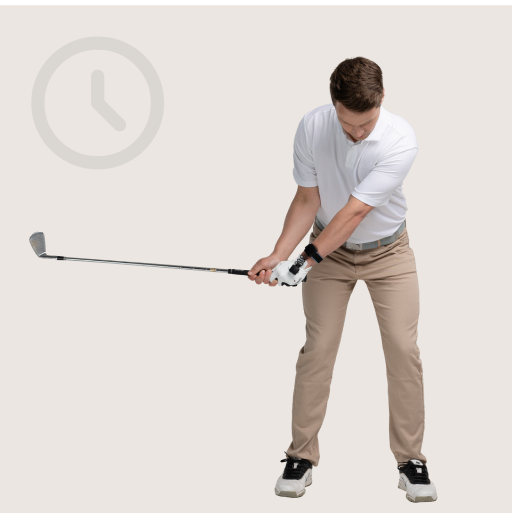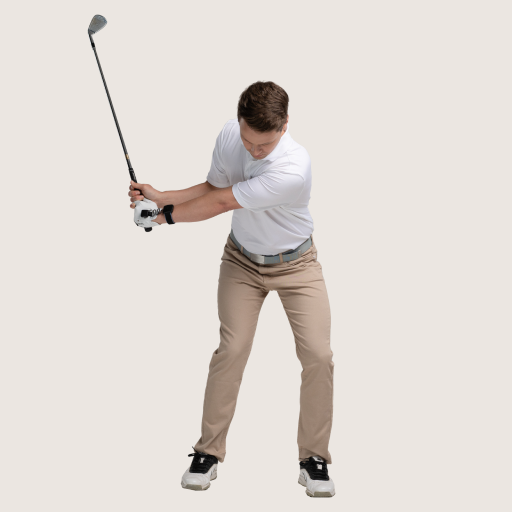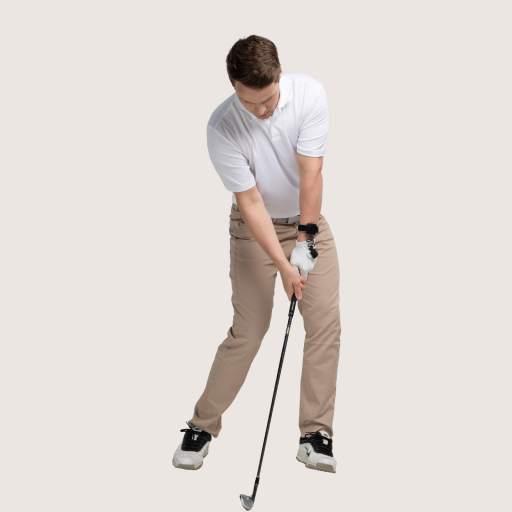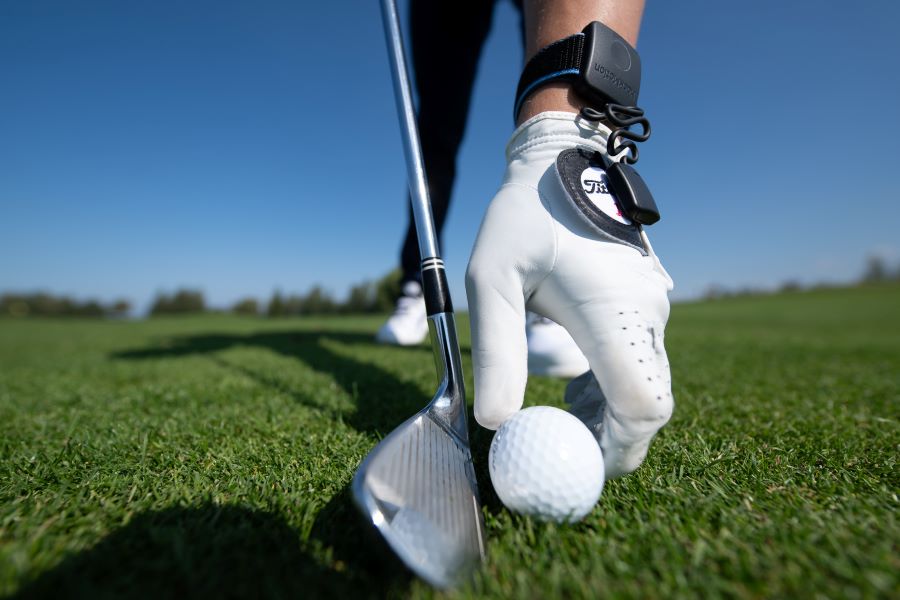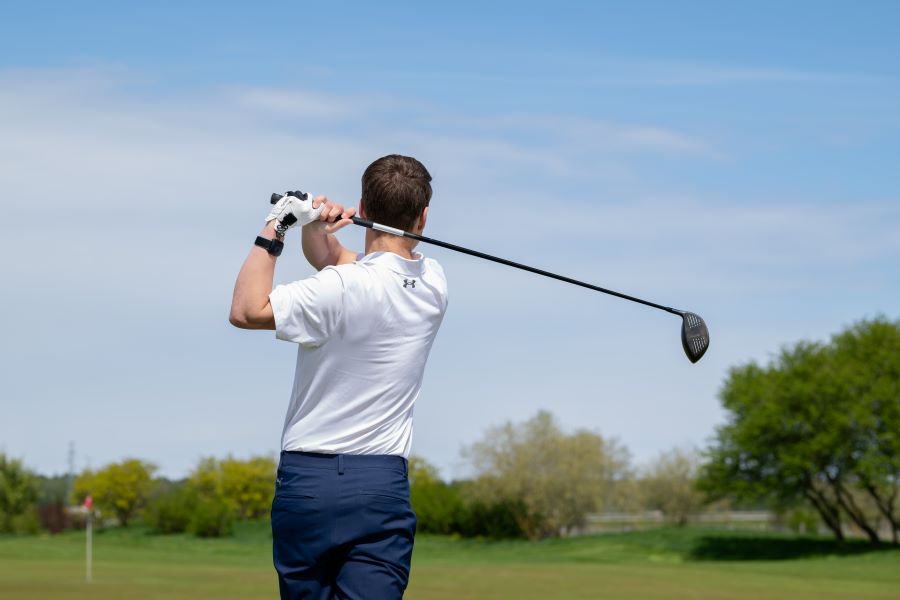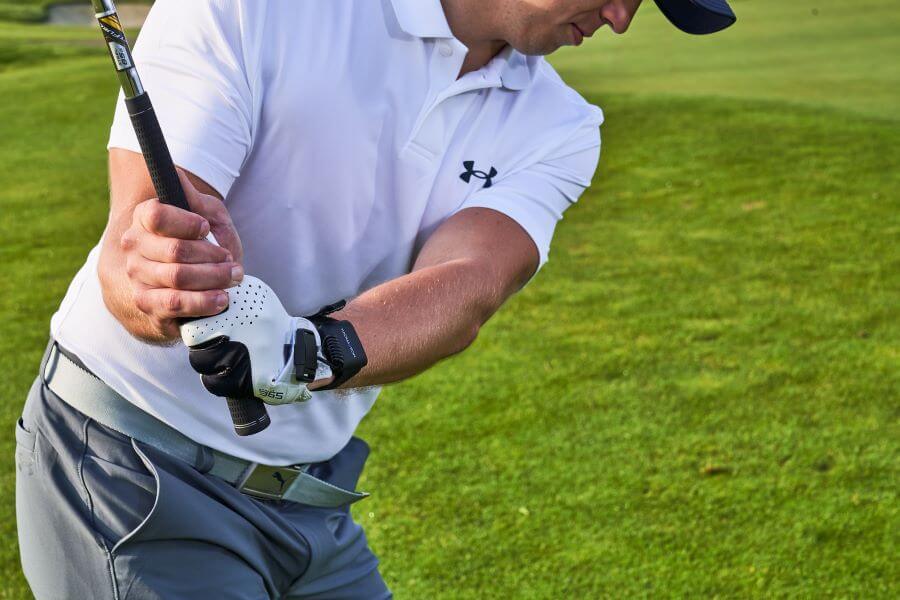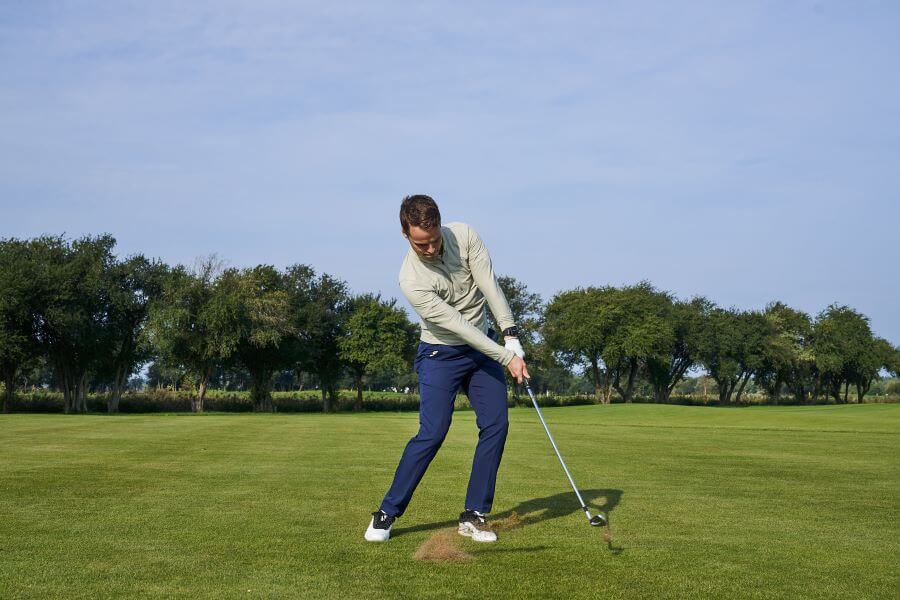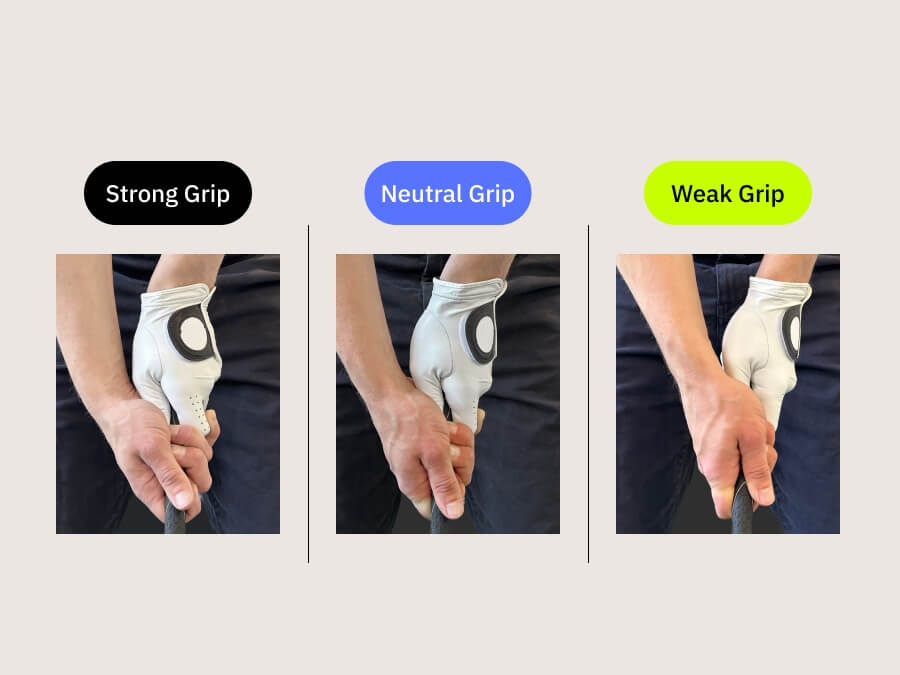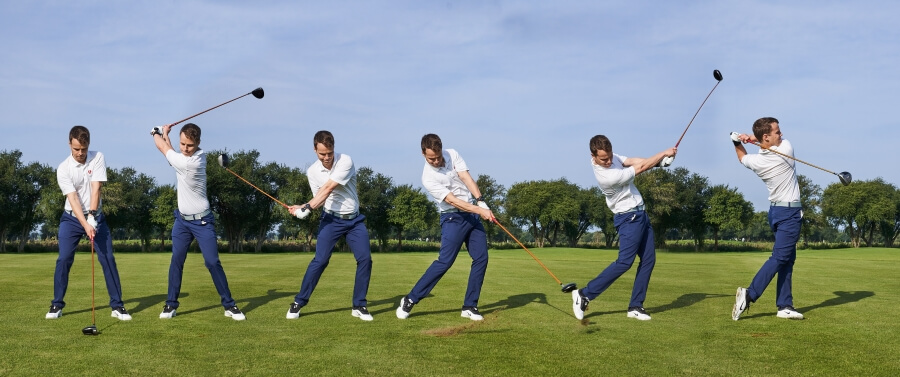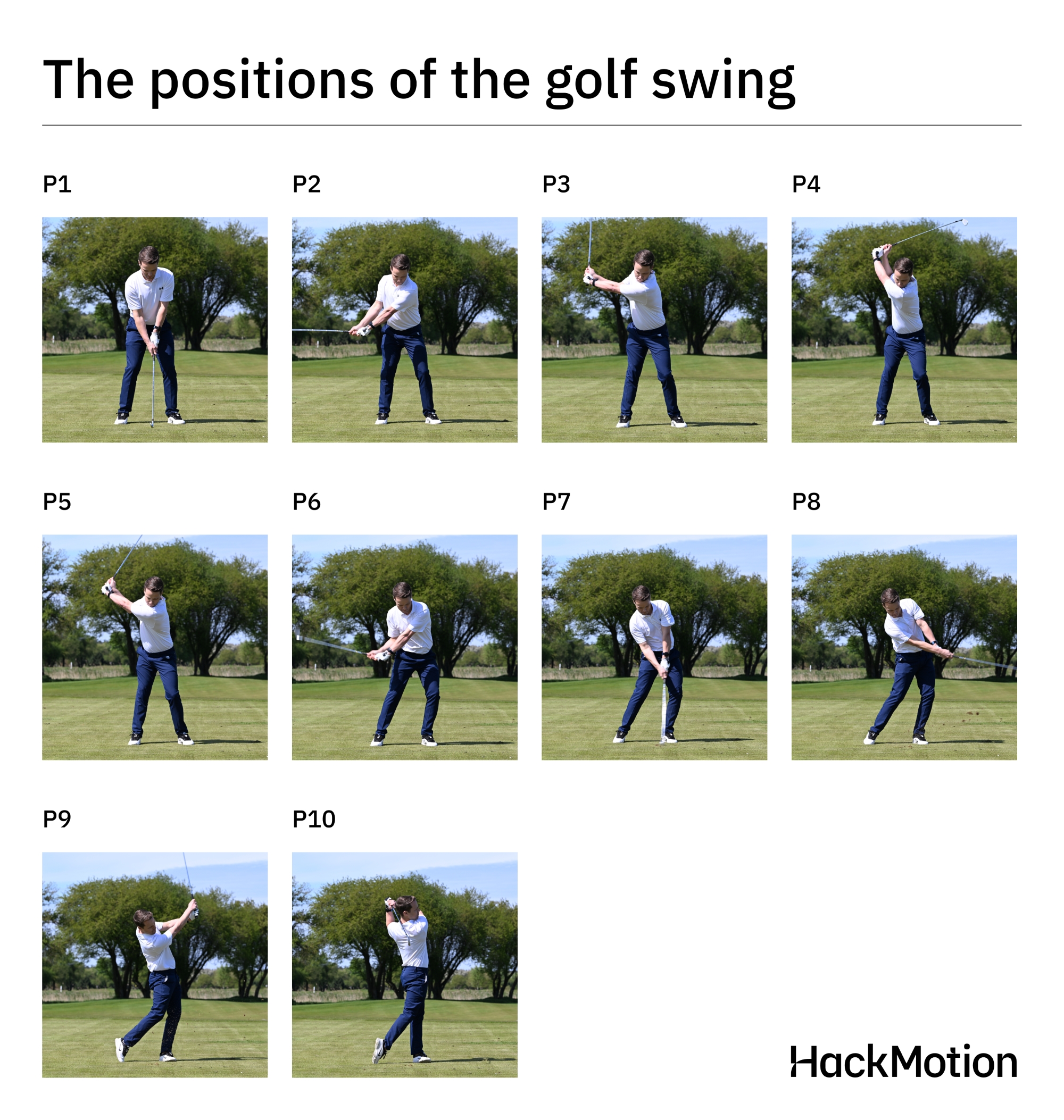Golf Ball Flight Laws (What You Need To Know & Common Misconceptions)
What makes your golf ball turn left, right, push, pull, slice, and hook?
Is it your hand position, the fact that you slide your hips, or do you think you picked your head up?
Chances are, that’s not what happened. Golfers have plenty of reasons or excuses that they believe cause their golf shots to do what they do.
However, one thing determines your golf ball’s flight. That one thing is the clubface angle at impact.
Understanding the golf ball flight laws will allow you to hit straighter, more consistent golf shots.
Contents
- What are Golf Ball Flight Laws?
- What is the Importance of Ball Flight Laws?
- What are the Different Types of Ball Flight?
- What Factors Have an Impact on Ball Flight?
- Factors That Influence the Golf Ball After Impact
- How to Use Ball Flight Laws to Improve Your Game?
- Analyzing Your Own Ball Flight
- FAQs
- Final Thoughts
What are Golf Ball Flight Laws?
The golf ball flight laws are a list of directions and angles at which the golf ball travels based on what happens at impact.
The old golf ball flight laws were largely based on the club’s path; the new ones are more about the clubface angle at impact.
Without golf ball flight laws, we would not understand the difference between a fade and a draw and why one golf shot can go straight and the next can hook.
What is the Importance of Ball Flight Laws?
Many amateur players believe that the golf ball flight laws are for professionals.
In reality, golf ball flight laws are for all players. They help solve problems with the golf swing. If you are tired of hitting a slice or a hook while out on the course, these laws could change your game and your approach.
Thanks to modern golf technology and things like TrackMan, Foresight, and HackMotion, we have learned much about what happens at impact and how players can benefit from this data to improve.
The most significant of these findings is this:
- The clubface at impact determines the direction of the ball.
- Swing path, in relation to the clubface, determines the curvature of the ball.
With the golf ball flight laws, we can get much more information from launch monitors and similar technology that gives actional tips for improving your game.
| Shot | Face (To Target) | Path | Face (To Path) |
|---|---|---|---|
| Straight | Square to Target | Straight | Square |
| Straight Slice | Square to Target | Outside to Inside | Open |
| Straight Hook | Square to Target | Inside to Outside | Closed |
| Push Slice | Open to Target | Straight | Open |
| Push Straight | Open to Target | Inside to Outside Path | Straight |
| Push Hook | Open to Target | Inside to Outside | Closed |
| Pull Slice | Closed to Target | Outside to Inside | Open |
| Pull Straight | Closed to Target | Outside to Inside | Square |
| Pull Hook | Closed to Target | Straight | Closed |
Notice with the new golf ball flight laws; we look at the face’s direction to the target and the relationship of the face to the path.
The important takeaway is that the face (both in relation to the target and the path) will decide where the ball will go. The path plays into curvature a bit, but again, the clubface angle is key.
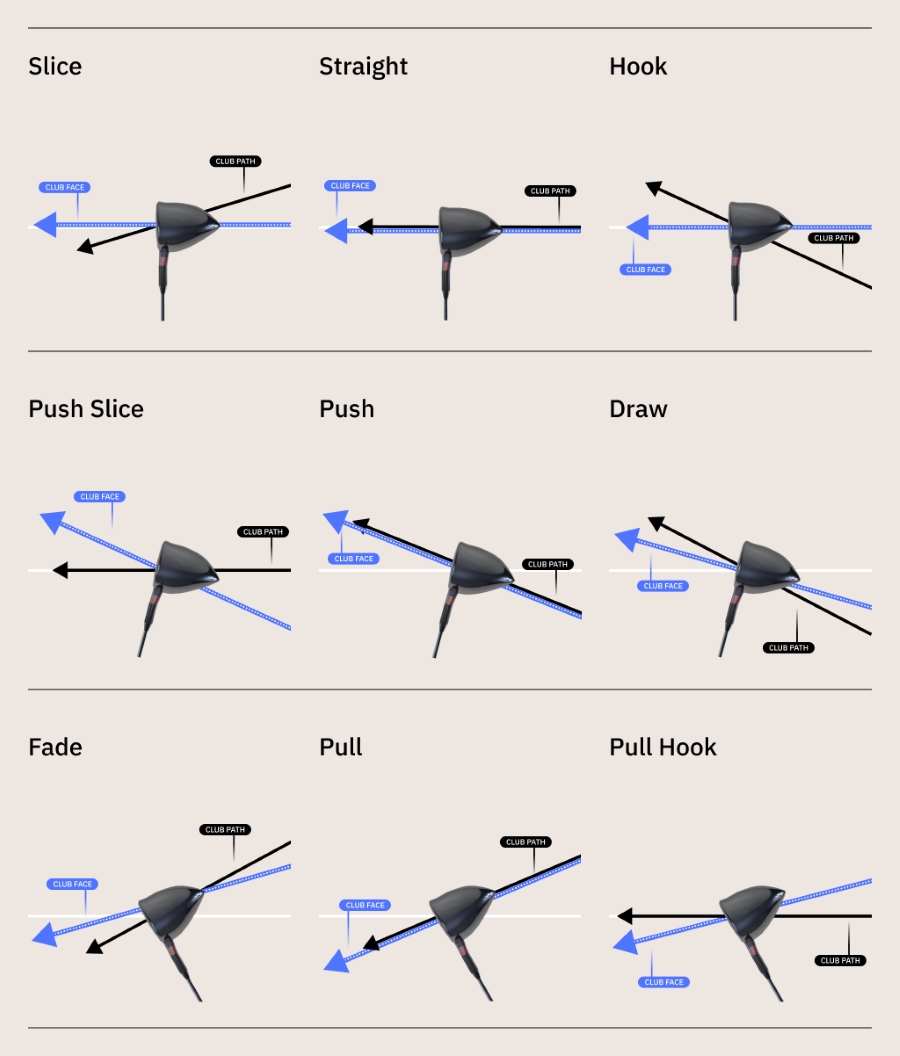
What are the Different Types of Ball Flight?
Different types of ball flight take into account the way the ball leaves the clubface and then the way the ball curves.
For instance, you can hit a shot that starts left of your target and stays left, or you can hit a shot that starts left and then turns left.
Here is the ball flight terminology you should know, as well as what to expect if you hit any of these shots.
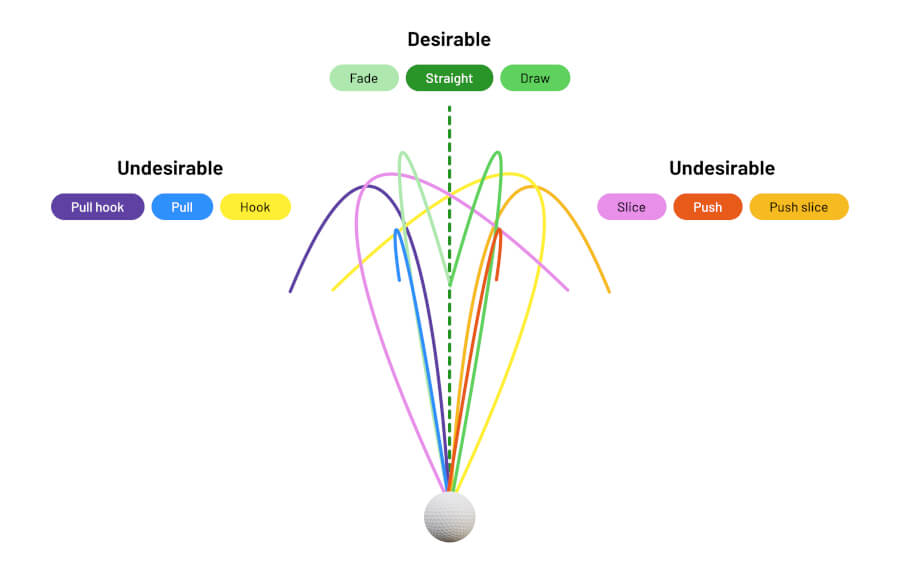
If you think a slice or a hook are the only ball flight options, think again. The ball can start in three ways, a push, a pull, or a straight shot:
- Push: the ball goes right of the target from the time it comes off the clubface.
- Pull: the ball goes left of the target line immediately after impact.
- Straight: the ideal initial ball flight, right down the center of the fairway.
Once you have those initial flights, you have to also consider curvature:
- Fade: a golf ball that curves slightly right of the target fall to the right.
- Slice: a golf ball that takes a significant turn to the right.
- Hook: a golf ball that turns hard left.
- Draw: a golf ball that turns slightly left falls to the left side.
- Straight: a golf ball with no curve.
Finally, we combine the initial shot direction with curvature, and then we can talk about your true ball flight and what you are experiencing out on the course.
We often discuss these combinations using the terminology slice and hook. However, you can easily substitute in a fade or a draw (just expect a little less curvature).
- Push: the ball goes to the right of the target with no additional curvature.
- Push Slice: the ball goes to the right of the target and then continues to turn further right.
- Push Hook: the ball goes to the right of the target and then turns back to the left with a larger curve.
- Straight: a straight shot comes off the face square and never turns.
- Straight Slice: the ball goes straight when it starts and takes a significant turn to the right.
- Straight Hook: ball comes off the clubface straight and then hooks to the left.
- Pull: starts left of the target and never curves.
- Pull Hook: starts left of the target and then continues to turn further left.
- Pull Slice: shot starts left of the target and then slices back to the right.
What Factors Have an Impact on Ball Flight?
The new golf ball flight laws show the importance of the clubface at impact, but other factors also impact ball flight.
These include speed, launch angle, spin, and direction.
Ball Speed
The more ball speed we can generate, the easier it is to get distance. Distance gets us closer to the hole and makes approach shots considerably easier.
Ball speed is the initial speed at which the ball is hit. It’s often confused with clubhead speed, but ball speed is different from clubhead speed.
The ball speed will determine how far a golf ball will travel through the air. The more ball speed you have, the further the ball should travel.
Launch Angle
Depending on your angle of attack, the golf ball will launch at a specific angle. The launch angle impacts trajectory.
Years ago, we thought a lower trajectory would lead to a longer total distance, but we have since found that a high trajectory keeps the ball up in the air and travels considerably further.
The launch angle with shorter irons and wedges should be higher than it is with the longer irons and fairway woods.
Spin
Spin, especially side spin imparted on a ball, will impact the ball’s flight. Where most golfers see the way spin impacts their shots is after the ball lands. When the ball lands and stops, it has a lot of backspin.
If it has a lot of forward spin when it lands it will roll forward. Forward spin is great on a drive but not great with a wedge shot. Overall, spin rates also impact the trajectory and direction of your golf shots.
Spin rates are a major factor to look at and consider when deciding on which club to purchase.
Clubface Direction
The direction of the clubface at impact will determine the ball’s initial direction.
In addition, the direction of this clubface in relation to the swing path will determine the way the ball curves.
Wrist Angles and Clubface Direction
A golfers’ control of their clubface has quite a bit to do with the angle of their wrists.
If you are unaware of how golfers control their wrist angle in their swing, check out our complete guide on wrist action in the golf swing.
Factors That Influence the Golf Ball After Impact
Once the golf ball leaves the clubface, several factors affect its flight. These include the ball’s weight, drag, and lift.
Weight
Under USGA regulations, a golf ball:
- Must not exceed 1.620 ounces in weight.
- Must have a diameter of at least 1.680 inches.
Any weight variation in a golf ball can significantly influence its flight characteristics.
Drag
The dimple pattern on a golf ball varies by manufacturer and affects drag, which is the force that resists the ball’s motion through the air.
A more efficient dimple design reduces drag and helps the ball maintain speed, ultimately increasing distance.
Lift
Lift is the upward force on the ball, dictating how high it travels. The launch angle primarily determines lift, but compression can also play a role.
Weight, drag, and lift govern the ball’s overall flight and distance.
How to Use Ball Flight Laws to Improve Your Game?
Now that you understand more about the golf ball flight laws let’s take a more detailed look at how you can use this information to help your game.
As always, it’s great to be an expert in golf, but we need to use this info to shoot lower scores.
Example 1: Correcting a Pull
When we look at our new ball flight laws, we know that a pull is a shot that starts left of the target and then stays left of the target.
We know that a pull happens because a golf ball is struck with a clubface that is closed to the target line. This means the clubface is pointed to the left of the target at impact.
With this issue, there is likely a problem on the downswing that causes the clubface to come over the top on the outside in path.
In addition, your wrist angle and position at the top of the backswing cause the clubface to be a bit shut. Working on both of these things should fix the pull shot.
To Fix the Pull:
Try the Inside Out Gate Drill to fix your pull. Wearing the HackMotion to gather feedback and data while you complete this drill will make it more effective.
Inside Out Gate Drill – Step by Step:
- Set Up & Align: Choose an intermediate target and set your clubface toward it.
- Create the Gate: Place two tees or sticks—one just behind/outside and one in front/inside of the ball—to form a swing “gate.”
- Focus on Arm Motion: At the top, feel your arms lower (like a reverse bicep curl) before you start rotating.
- Use HackMotion Feedback: Monitor your wrist and clubface motion to ensure a proper inside-to-out swing path.
- Swing Through the Gate: Practice slow-motion swings through the gate, then progress to full swings while keeping your club path inside-out.
Example 2: The Dreaded Slice
The slice is the most common miss in golf. In our chart with the new golf ball flight laws, we call this the straight slice.
Although those two words don’t seem to fit in the same sentence, when you hit a slice, the ball does travel straight, to begin with.
The straight part of the ball flight doesn’t last for long as the slice spin takes over and starts turning the shot to the right.
With a slice, the swing path is more closed than the clubface. Again, we see how important learning to square the clubface is.
To Fix the Slice:
To fix a slice, the clubface needs to be square at impact and square to the swing path. One of the best ways to fix a slice is to use a drill called the Motorcycle drill.
The Motorcycle Drill helps to ensure your clubface is squaring up as you move towards impact.
Motorcycle Drill – Step by Step:
- Mimic the Throttle: Grip the club and twist your lead wrist like you’re slowing a motorcycle’s throttle.
- Reduce Extension: Focus on decreasing lead wrist extension at the top of your swing to avoid an open clubface.
- Transition to Flexion: As you move from the top to the parallel position (P6), consciously twist to increase wrist flexion.
- Sensor Feedback: Use the HackMotion wrist sensor to monitor the change—aim for an increase in flexion (e.g., from ~8° to ~18°).
- Adjust Ball Flight: Use the drill’s feedback to fine-tune the twist; too much twist closes the face (draw), and too little keeps it open (slice).
Example 3: A Straight Shot
There is always so much talk about how the golf ball turns and how it comes off the clubface, and sometimes, we don’t focus enough on what it takes to hit a ball straight.
Anytime you did not hit a golf ball straight, you had an issue with the clubface at impact. The quicker you can figure out the issue and then make adjustments to square the face, the easier it is to hit a straight shot.
Straight shots have a clubface that is square to the target; they have a straight path and a face that is square to that path.
Seems simple, right?
The release drill is a great practice drill for golfers who struggle with their impact position and trying to hit a straight shot. With this drill, you train your release on a short swing before adding more power and length to the golf swing.
Perfect Your Release with HackMotion
Fine-tune your release for consistent contact. Start with a short swing to master control before adding power.
HackMotion Release Drill – Step by Step
- Set Up: Address the ball with a shorter swing in mind.
- Club Parallel to Ground (P7) to Impact: Swing from club parallel in the downswing into impact.
- Hands Forward: Aim to keep your hands slightly ahead of the ball at impact.
- Check Wrist Angles: Use HackMotion to confirm that your wrist angle is in the correct “in range” zone.
Example 4: Straight Hook
A hook is another common shot that many golfers hit. Many say the hook is caused by tempo or coming from the inside.
What we know about a hook is that your face will be square to the target, and the path of the club is inside to out.
This is why when you hit a hook, you feel like you are swinging out to the right of the target, but the ball goes left. The clubface is closed to that path. The more closed it is, the more the ball hooks.
To Fix a Hook:
- Neutral Grip: Adjust your grip to a more neutral/weaker position (about 2 knuckles visible on your lead hand) to avoid over-closing the clubface.
- Wrist Check: Use the HackMotion sensor (or focus on feel) to ensure your lead wrist stays in a proper, stable position—not overly flexed—to keep the clubface from closing too early.
- Head Cover Drill: Place a headcover about a foot in front of your ball (inside the ball) to force an out-to-in swing path; if you hit the head cover, you know you’re swinging too much from the inside.
- Alignment Rod Visual: Set up an alignment rod at a 45° angle as a visual guide to encourage swinging more from the outside, helping to keep your clubface neutral.
- Feedback & Adjust: Practice slow swings, monitor your ball flight and sensor feedback, then gradually build speed as you dial in a swing path that eliminates the hook.
Analyzing Your Own Ball Flight
Let’s ensure you know how to analyze your ball flight and correctly use the golf ball flight laws. For starts, ensure you understand that these ball flights work for left- and right-handed players.
However, a slice for a right-handed player goes straight and then turns to the right; for a left-handed player, the ball goes straight and then turns to the left.
Divot Checking
You will watch your ball flight and learn from where it goes. However, you can also look at your divot pattern and see what you can learn about that.
Most divot patterns will give you an example of your club’s path; it’s a little harder to determine the clubface angle from the divot.
Alignment Sticks
It’s important to have alignment sticks set up when practicing your putting. The alignment sticks will give you an indication of what you are aiming at.
Sometimes, golfers think they pulled a shot, but they aim too far to the left of their target.
Launch Monitor
Launch monitors like Trackman can give you real-time data on the angle of your clubface and its position in relation to the path.
This advanced launch monitor data with path information is usually only offered on higher-end launch monitors. Cheaper portable launch monitors are used more for ball data.
HackMotion
The HackMotion wrist sensor can determine the exact wrist angles you need to square the clubface at impact.
HackMotion helps you measure and analyze a part of your swing that you may not have been able to understand otherwise.
One of the key pieces of data that HackMotion has given us is that professional golfers do a very good job of squaring their clubface to the path long before they get to impact.
You may be able to learn from HackMotion that your clubface is squaring up too late.
The best part?
HackMotion eliminates the guesswork, allowing you to refine your swing with real-time feedback and guided drills.
FAQs
Here are a few things to know about the golf ball flight laws, common misconceptions, some things you should know, and final thoughts regarding how these laws impact your game.
How do you read a golf ball flight?
When reading a golf ball flight, ensure that you have a proper idea of what straight is. Many golfers are not lining up their golf shots, and what they think is straight is actually left or right. Use alignment sticks, pick a target, and then use this diagram to read your ball flight.
What is the ideal ball flight?
Golfers who can hit a straight shot will find an advantage on the golf course. However, if you can eventually learn to control ball flight and hit a fade or a draw when necessary, it’s a tremendous benefit to scoring.
How do you hit different ball flights?
The angle of the clubface mostly determines the ball flight of your golf shots at impact. In addition to the angle, you may also see an impact due to the club path.
As shown here, you must change the clubface angle at impact if you want to hit different ball flights.
What makes a golf ball fly straight?
A golf ball hit with a square clubface on a straight path will fly straight. When the clubface angle changes, you can hit a shot that goes straight left or straight right, but it won’t be straight in relation to the target line.
What controls the direction of your golf ball flight?
The wrist angles in your golf swing control the flight of the golf ball. The angles at setup, backswing, and downswing as they transition into the golf ball all impact the ball’s flight and direction.
Final Thoughts
Golf ball flight laws are nothing that you need to harp over or think about when you are on the golf course.
In addition, this change from old ball flight to new ball flight laws further proves that golfers should focus on the clubface angle at the ball.
Practice controlling your clubface using the HackMotion wrist sensor to see tremendous improvement in your game.


